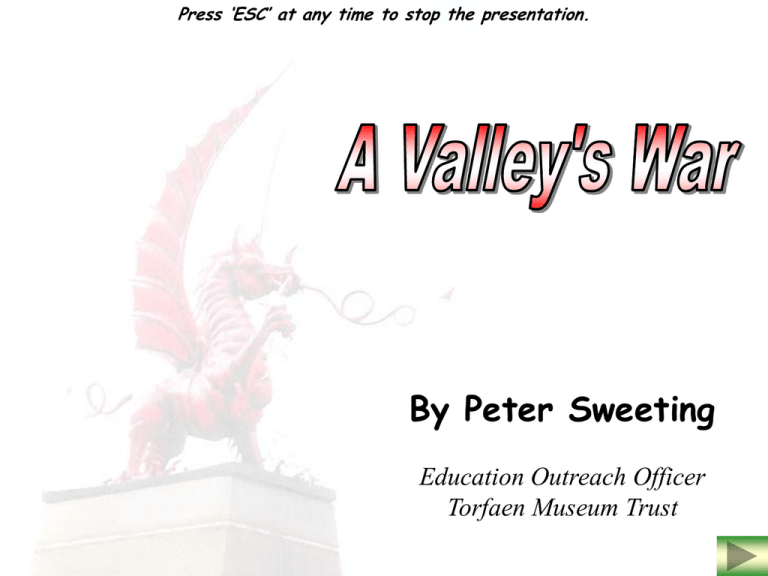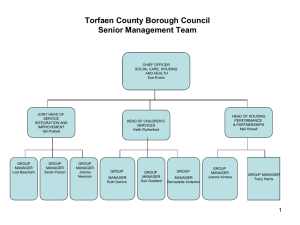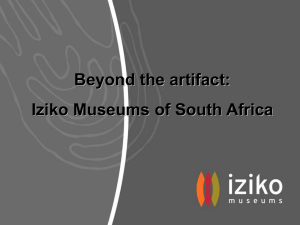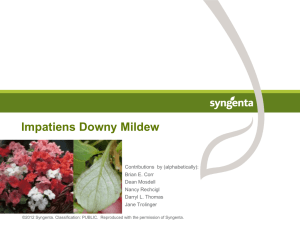our_valleys_war - Rhondda Remembers
advertisement

Press ‘ESC’ at any time to stop the presentation. By Peter Sweeting Education Outreach Officer Torfaen Museum Trust When was this memorial unveiled in Panteg? What does this tell you (along with the inscription) about how people viewed the Great War of 1914-1918? Reproduced by kind permission of Torfaen Museum Trust The Memorial in 2005 Reproduced by kind permission of M. Williams Who does this document belong to? What job did this person do and where did they live? Why do you think that British citizens were ‘Registered’ during and after 1915? Reproduced by kind permission of Torfaen Museum Trust When soldiers joined up to go to war they were presented with a Small Book. Any entry in the Small Book was supervised by a superior officer. The contents gave general guidance and information to the soldier, but it also contained personal information and documentation. Such facts as your regiment and regimental number, postal address, height, eye colour and even bodily marks (just in case you had to be identified) were added. It also contained details of your next of kin ‘still living’ . This was in case a soldier were badly wounded or killed. If he were killed in action (K.I.A) the next of kin would be sent the Small Book and its contents. This is part of a Small Book Who did this Small Book belong to and where was he from? What else can you find out about this soldier? Which Regiment did he belong to? Where was he born? How old and how tall was he? What was his job before the war? Does he have any ‘Marks’? What religion did he follow? Reproduced by kind permission of Torfaen Museum Trust This is part of a Small Book Who is Ernest’s only next of kin still living and where does she live? Reproduced by kind permission of Torfaen Museum Trust A typical enrolment advert from WWI Why did men volunteer to go to war? Knowing what you do about war, would you have joined up? Click here to enlarge One of the men who answered the call and joined up in South Wales. Describe the uniform that this man is wearing. What is the object slung across his chest used for? What is he wearing on the lower part of his legs? Why? What is on his cap badge? Reproduced by kind permission of Torfaen Museum Trust Which armed service do you think this gentleman belonged to? What helped you to make up your mind? Reproduced by kind permission of Torfaen Museum Trust Many men who were swept up by the wave of enthusiasm for war were extremely young. How old do you think that this soldier is? Which regiment do you think he joined? (Look at his cap badge, his feet and what he is holding) Reproduced by kind permission of Torfaen Museum Trust As more and more young men joined up to go to war, some women fought to keep them at home. Not everyone was convinced of the Country’s need! Below is an extremely persuasive letter sent to a troubled mother by the Parliamentary Recruiting Committee. Click here to enlarge the documents Transcript December 1914 Dear Sir and Madam We desire to draw your attention to the enclosed form, in which you are asked to state the names of your household who are willing to enlist for the War. By filling in and posting the Householder’s Return without delay, you will be entered in a Register, and the nearest Recruiting Office will arrange to attest those registered as their services are required. There has been a generous response to the appeal for men for the new armies, but the numbers of recruits, though large, does not nearly meet the Nations need. In order to maintain and reinforce our troops abroad and to complete the new armies which we hope within a few months to throw into the field, we and all the best the Nation can give us of its youth and strength. If we are to repair as far as may be humanly possible the immeasurable wrongs inflicted on our Allies, if we are to avoid for ourselves the ills which they have suffered, if we are to maintain for our children all that we hold dear – honour, freedom, our way of life as a Nation – we must fight with the courage and endurance which was for us the struggle of the past. Every man, therefore, who is eligible will ask his own conscience whether, in this emergency, it is not his duty to hold himself ready to enlist in the forces of the brave. The difficulties and dangers which confront us have never been so great; we await the issue with confidence, relying on the spirit and self-sacrifice of our fellow countrymen to prevail. We are your obedient servants W.W.Asquith, A.Bonnar Law, Arthur Hendusoy ? (Presidents) Mrs Bowen and her friend ‘doing their bit’ for King and Country as lady porters at Cwmbran railway station. Can you think of any other jobs that women may have been expected to do during the war? Why was this? Reproduced by kind permission of Torfaen Museum Trust Women munition workers employed by the Blaenavon Works at Forge Side. Such was the quality of their work that a high commendation came from no less a person than David Lloyd-George, the Prime Minister of the wartime coalition government. Reproduced by kind permission of W.G. Lloyd Can you see what one of the ladies in the front row is holding? Makepiece’s Angels - so named because the foreman of the nut and bolt fitting shop at the Nut and Bolt Works Cwmbran, was Mr. Makepiece, a man of fine character who also used to be the Captain of Pontnewydd Fire Brigade. Reproduced by kind permission of W.G. Lloyd Are you surprised by some of the ages of these workers? Not every man could be called up. Necessary trades and skills meant that their time was needed for the war effort. Reproduced by kind permission of W.G. Lloyd What can you see within this photo that indicates that it was taken during wartime? Soldiers waiting for their train at Crane Street Station, Pontypool. Reproduced by kind permission of Torfaen Museum Trust Fox Camp What gives you the impression that some training camps were speedily put together? Reproduced by kind permission of Torfaen Museum Trust Why do you think that it was important for soldiers to involve themselves in everyday activities like playing sport? Reproduced by kind permission of Torfaen Museum Trust Soldiers of the 2nd Battalion Monmouthshire Regiment in a trench near Le Bizet, France, April 1915. What features of a trench can you pick out? Reproduced by kind permission of the South Wales Borderers Museum Behind the line, after the Battle of the Somme 1916. Reproduced by kind permission of Torfaen Museum Trust South Wales Borderers officers and men. Many ‘Ponty’ boys are in this photo. Reproduced by kind permission of Torfaen Museum Trust When not actually fighting, the men often turned their hand to art, using the raw materials around them. This photograph shows Belgian soldiers making trench art vases out of shell cases on the Yser front line, north of Ypres in Belgium. Reproduced by kind permission of W.G. Lloyd Trench Art Today – the old with the new! Located in the middle of the Somme battlefield, the Golden Madonna and Child was hit by shellfire in 1915 and leaned at a precarious angle until 1918. It is commemorated here in a 1990’s mural. The basilica at Albert in 1999 Reproduced by kind permission of W.G. Lloyd People of all ages were urged to contribute to helping the ‘Boys’ at The Front. Who has this certificate been awarded to and what for? Reproduced by kind permission of Torfaen Museum Trust Sponsorship is nothing new! This picture shows the ship, ‘HMS Pontypool’’ that the people of Pontypool ‘adopted’ during the First World War. The people of Pontypool adopted another ship – H.M.S. Kittiwake - during the Second World War too! Reproduced by kind permission of W.G. Lloyd What do you think was involved in adopting a warship? (What would the people of Pontypool have had to have done?) Reproduced by kind permission of W.G. Lloyd A gift from the Eastern Valleys. A Motor Ambulance donated by the inhabitants of Monmouthshire as a gift to His Majesty’s Army. This photograph shows a captured German Gun outside Pontypool Town Hall. Why do you think that captured German weapons were displayed in public areas where they could be seen by everyone? Reproduced by kind permission of W.G. Lloyd Many civilians had fled from Northern France and Belgium and came to live in Great Britain to escape the horrors of war. This photograph shows Belgian refugees at Blaenavon. Reproduced by kind permission of W.G. Lloyd Reproduced by kind permission of W.G. Lloyd What is happening in this photograph? Do you remember looking at pages from Ernest Payne’s Small Book? Here is another of Ernest’s official documents. What is a certificate of discharge? What rank had Ernest reached by the time he was discharged? When was Ernest finally discharged from the army? Now that Ernest had served his country in the army, did that mean that he would not be called up to go to war in future? The Regimental Colours return to Pontypool June 7th 1919. Monmouthshire Regiment’s Colours Reproduced by kind permission of W.G. Lloyd Why do you think that this would have been such a happy and proud, yet also an extremely sad moment for the people of Pontypool and South Wales? The unveiling of Blaenavon Memorial Reproduced by kind permission of W.G. Lloyd Look at the size of the crowd in Blaenavon who turned up to witness the unveiling of the memorial to honour the local soldiers who fell during the Great War of 1914-1918. The Memorial in 2005 The unveiling of Blaenavon Memorial Reproduced by kind permission of W.G. Lloyd What does the unveiling of memorials such as this, the size of the crowds and the range of different people who turned up, tell you about the impact that the First World War had on local communities? The Memorial in 2005 Reproduced by kind permission of M. Williams There are other memorials and reminders of the war across the World and particularly in Europe where most of the fighting took place. Sanctuary Wood, near Ypres in Belgium, has been kept as a museum since 1919. In 1914 the wood was where men who had been separated from their regiments came to rest before rejoining the fight. The wood was captured by the Germans in 1918. More pictures of Sanctuary Wood Reproduced by kind permission of P. Sweeting Reproduced by kind permission of M. Williams Why do you think that the trenches zig-zagged across the landscape? These photographs give you some idea of conditions in the trenches Can you think of some key words to describe these conditions? Reproduced by kind permission of M. Williams A shattered tree stump within Sanctuary Wood. What does this tell you about the terrible damage that was inflicted upon men, animals and the landscape during the First World War? What could have caused such damage to the trees within these woods? A tragic memorial to shattered lives! Reproduced by kind permission of P. Sweeting Tyne Cot Cemetery in Belgium is the largest Commonwealth war cemetery in the world with 11,953 burials. The back walls record the names of 34,927 soldiers with no known grave. Reproduced by kind permission of P. Sweeting The Menin Gate Memorial to the Missing in Ypres contains the names of 54,896 officers and men from the Commonwealth forces who fell on the Ypres Salient before the 16th August 1917. Every evening at sundown buglers from the town play The Last Post and Reveille in memory of the fallen. Reproduced by kind permission of P. Sweeting This entrance to Pontypool Park is found opposite the Town Hall. It is known as the Memorial Gate. Reproduced by kind permission of M. Williams Reproduced by kind permission of M. Williams The Memorial Gate. On the pillars on either side and on plaques on the railings are listed the men from the local area who fell during The Great War and the Second World War. Reproduced by kind permission of M. Williams They shall not grow old as we grow old, Age shall not wither them nor the years condemn; At the going down of the sun and in the morning, We will remember them. Memorial to fallen Welsh soldiers at Mametz Wood Reproduced by kind permission of P. Sweeting END











